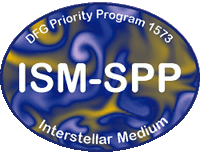DFG Priority Program 1573
ISM Data Centre
On this webpage we intend to provide a collection of ISM related images, animations, data and software
that can be used by everyone for lectures and talks, inspiration ...
If you have a nice picture or movie that you are happy to share with the
community, please send it to us (gritschneder[at]ism-spp.de) with a short
description and credit information and we will add it to our collection.
High resolution images or the animations are available by clicking on the thumbnail.
| The life-cycle of molecular clouds |
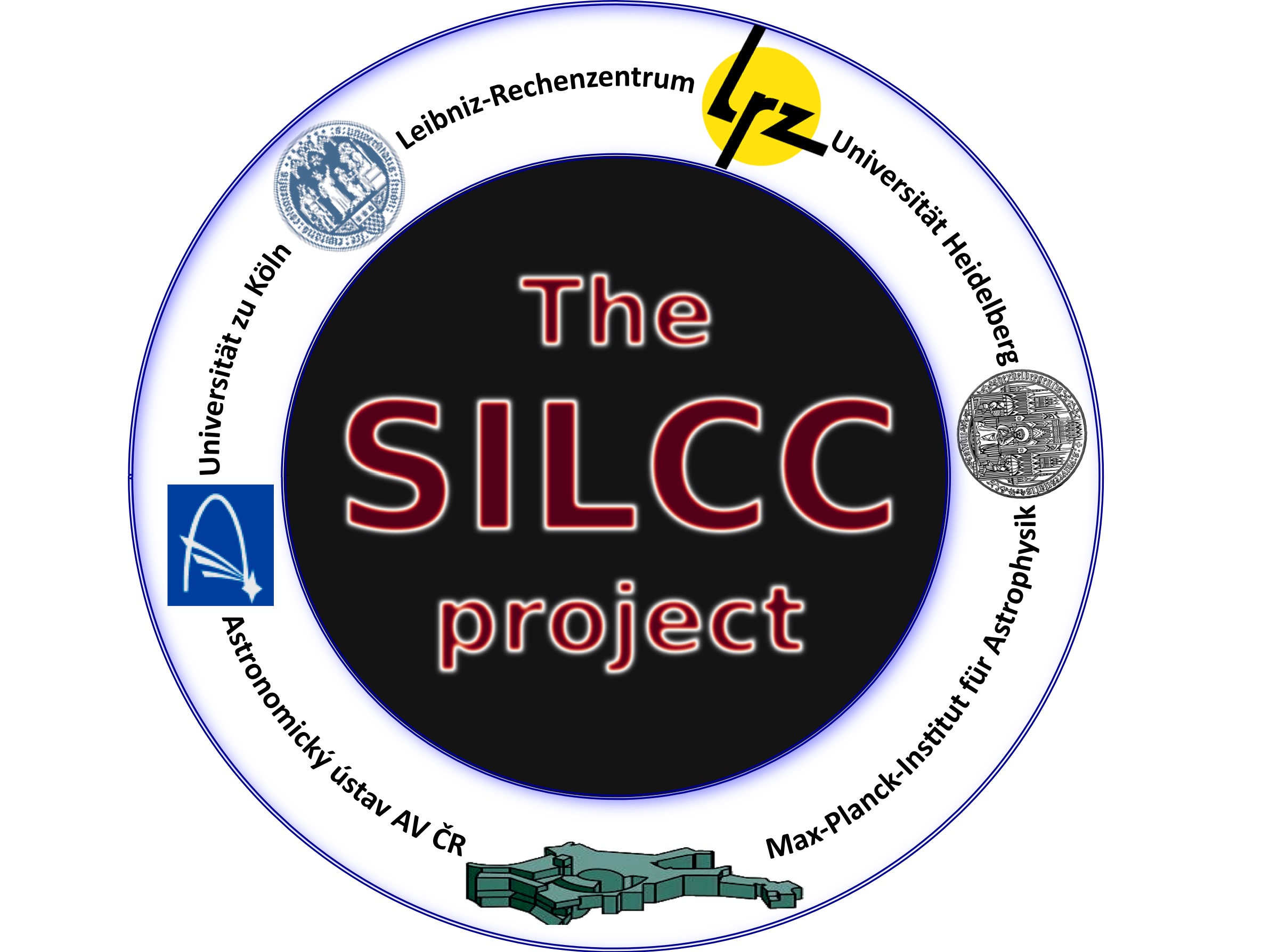 |
The SILCC project
A full understanding of the multi-phase structure of the turbulent
interstellar medium (ISM) is
one of the single most important challenges in modern astrophysics. The
complex interplay
and relative contributions of gravitational collapse, radiative cooling, the
formation and destruction
of molecules, the impact of ionising radiation, stellar winds, supernova
explosions
from massive stars, and the role of magnetic fields is still poorly
understood. It can only be
investigated in detail with challenging high-performance numerical
simulations. Triggered by
the establishment of the ISM SPP1573 about three years ago, a group of SPP
members (the
PIs of this proposal) have joined their expertise to investigate the
multi-phase ISM by means of
numerical simulations with an unprecedented combination of resolution and
physical complexity.
Supported by a major grant of computational time (42 million CPU hours at
SuperMUC)
we have developed and tested a massively parallel version of the
magneto-hydrodynamic,
adaptive mesh refinement grid code FLASH including self-gravity, chemistry,
and radiative
transfer for point sources and diffuse radiation fields. With this unique
tool, we will simulate
the full life-cycle of molecular clouds in the ISM in different environments,
from their assembly
through to their destruction by stellar feedback and the launching of
multi-phase galactic
winds. We will also post-process our simulations to generate synthetic line
emission maps
and dust continuum images that we will compare in detail with data from
state-of-the-art observational
surveys, including some for which we have privileged access. This will allow
us to
self-consistently address key science questions with unprecedented precision
and predictive
power: How do molecular clouds form and how are they dispersed by massive
stars in galactic
discs of varying surface density? What is the respective role of ionising
radiation, stellar
winds and supernova explosions in this context? How is turbulence generated in
the molecular,
neutral and ionised phases of the ISM? How can the feedback from massive stars
drive
highly turbulent motions and multi-phase ISM galactic winds and outflows,
which appear to
be the main regulator for galaxy formation? What is the role of magnetic
fields? How can we
construct accurate synthetic observations from our simulations? How can novel
observations
of the ISM in the disc and in galactic outflows (e.g. molecular lines) be
interpreted theoretically?
Can we make definite scientific predictions for existing and upcoming
observations (e.g.
ALMA) of the galactic ISM across cosmic time? After finishing the initial
phase of method development,
we can now harvest on our investments and apply the capabilities developed in
the past years to address all the above questions in a major joint effort, for
which we ask for
the support within the SPP 1573.
Credit: The SILCC project - Universität zu Kön, MPA, ITA Heidelberg, Czech Academy of Sciences (Astronomical Institute) and Cardiff University,
supported by LRZ und Gauss Center for Supercomputing (GCS)
|
| Codes & Algorithms |
 |
KROME - a publicly available chemistry
package
KROME is a publicly available chemistry package for a wide range of
astrophysical simulations developed during the first funding period of the ISM-SPP. Given a chemical network (in CSV format) it automatically generates all the routines needed to solve the kinetic of the system, modelled as system of coupled Ordinary Differential Equations. It provides a large range of options which make it unique and very flexible, and a large set of physical processes connected to chemistry, including photochemistry, cooling, heating, dust physics and reverse kinetics. The package contains a series of pre-built chemical networks: primordial, low-metallicity, molecular clouds, planetary atmosphere, and a framework to model the dust grain population. Patches for 3D hydrodynamics codes ENZO, RAMSES, and FLASH are also released with the package.
KROME is an open-source code, GNU-licensed, and is available on
http://www.kromepackage.org
https://bitbucket.org/krome/krome_stable
Any update or news related to Krome will be announced on the
Krome user mailing list:
https://groups.google.com/forum/#!forum/kromeusers
Credit: T. Grassi, S. Bovino, D. R. G. Schleicher, J. Prieto, D. Seifried, E. Simoncini, F. A. Gianturco
|
| Interactive Exploration of Molecular Clouds |
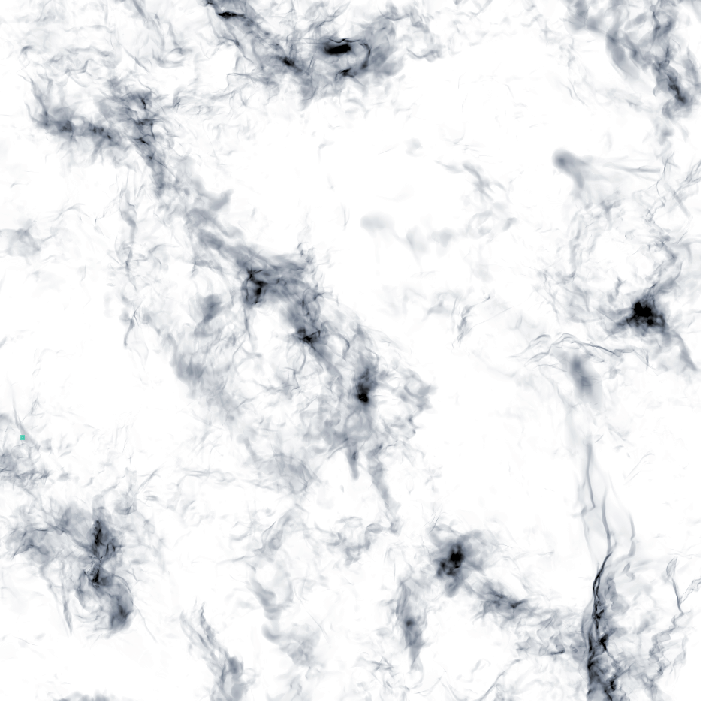 |
Line of sight velocity profiles in a 3D AMR simulation of turbulent molecular clouds
A snapshot from a three dimensional simulation of a turbulent
molecular cloud can be interactively analysed and line profiles can
be obtained. Initially, the gas began with fully developed
turbulence at Mach 8, included about 5,700 Solar masses of gas in a 10 pc periodic box.
The snapshot shown is after 1.27 Myr of self-gravitating evolution.
Click around the image to explore the line-of-sight velocity structure.
Credit: Nicholas Moeckel (USM/LMU Munich)
|
| Molecular Clouds |
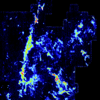 |
The Cygnus X molecular cloud and high mass star forming complex in radio light
The movie shows the emission of the 13CO 1-0 spectral line in channels of the local standard of rest (LSR) velocity.
The data have been observed with the Five College Radio Astronomy Observatory (FCRAO) near Amherst, Massachusetts.
A total of ~800,000 spectra were observed, covering an area of about 35 square degrees of sky (180 times the area covered by the full Moon).
Credit: Robert Simon (KOSMA, I. Physikalisches Institut, Universität zu Köln)
and Nicola Schneider (Observatoire de Bordeaux, Bordeaux university)
|
| The Galactic Centre |
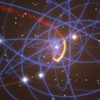 |
The Galactic Centre cloud G2 on its way towards Sgr A*
Animation of a hydrodynamical simulation of the recently discovered Galactic Centre cloud G2 (Gillessen et al., 2012) on its way towards Sgr A*.
Also shown are the orbits of the S-stars in front of a background star field.
Related publications: Gillessen et al., 2012, 2013a, 2013b; Burkert et al., 2012; Schartmann et al., 2012
Credit:ESO/MPE/M. Schartmann/L. Calçada
|
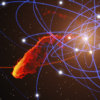 |
The Galactic Centre cloud G2 on its way towards Sgr A*
Snapshot of a hydrodynamical simulation of the recently discovered Galactic Centre cloud G2 (Gillessen et al., 2012) on its way towards Sgr A*.
Also shown are the orbits of the S-stars in front of a background star field.
Related publications: Gillessen et al., 2012, 2013a, 2013b; Burkert et al., 2012; Schartmann et al., 2012
Credit:ESO/MPE/M. Schartmann
|
 |
G2 modelled as a mass-losing source of gas
Three snapshots of a hydrodynamical simulation of the recently
discovered Galactic Centre cloud G2 (Gillessen et al., 2012) on its
way towards Sgr A*,
modelled as a mass-losing source of gas. The simulation is the
standard model of Ballone et al. (2013) with a mass loss rate of
8.8e-8 solar masses per year and a wind velocity of 50 km/s.
Related publication: Ballone et al., 2013
Credit:A.Ballone (USM/MPE Munich)
|
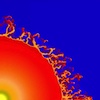 |
G2 modelled as a mass-losing source of gas
Animation of a hydrodynamical simulation of the recently
discovered Galactic Centre cloud G2 (Gillessen et al., 2012) on its
way towards Sgr A*,
modelled as a mass-losing source of gas. The simulation is the
standard model of Ballone et al. (2013) with a mass loss rate of
8.8e-8 solar masses per year and a wind velocity of 50 km/s.
Related publication: Ballone et al., 2013
Credit:A.Ballone (USM/MPE Munich)
|
Public Relations
| Media Response |
| September 18th 2010 |
14,4 Millionen Euro für Weltraumforschung, Süddeutsche Zeitung |

This priority program is funded by the
German Research Foundation DFG.

 This priority program is funded by the German Research Foundation DFG.
This priority program is funded by the German Research Foundation DFG.
